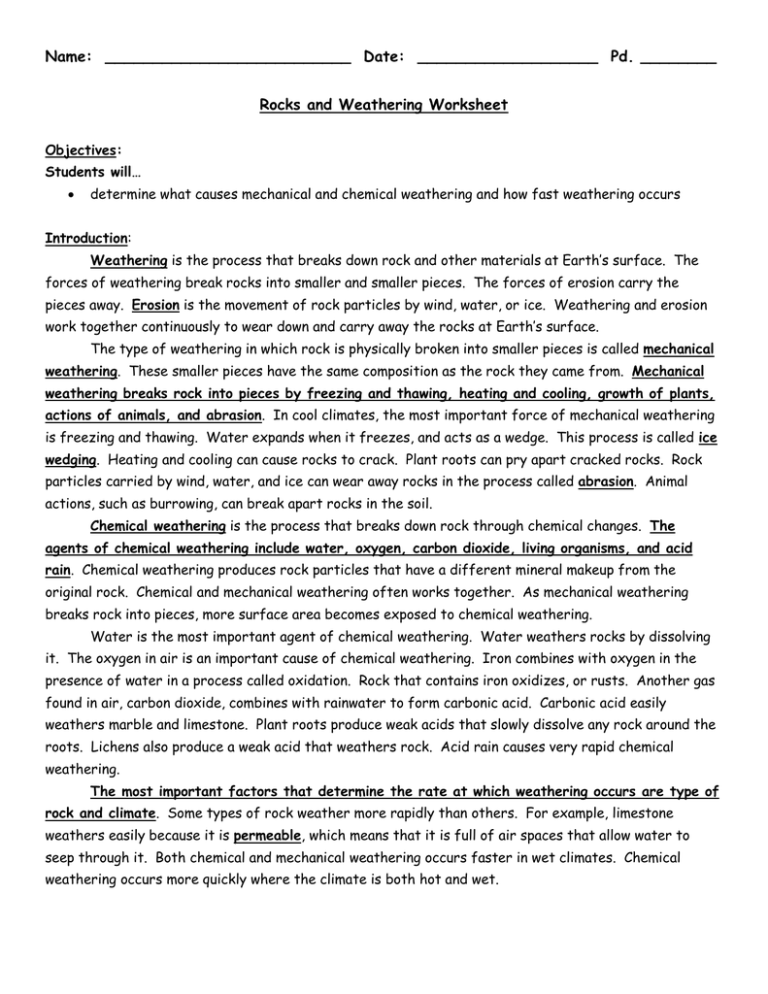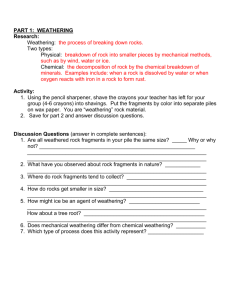Rocks and Weathering Worksheet
advertisement

Name: __________________________ Date: ___________________ Pd. ________ Rocks and Weathering Worksheet Objectives: Students will… determine what causes mechanical and chemical weathering and how fast weathering occurs Introduction: Weathering is the process that breaks down rock and other materials at Earth’s surface. The forces of weathering break rocks into smaller and smaller pieces. The forces of erosion carry the pieces away. Erosion is the movement of rock particles by wind, water, or ice. Weathering and erosion work together continuously to wear down and carry away the rocks at Earth’s surface. The type of weathering in which rock is physically broken into smaller pieces is called mechanical weathering. These smaller pieces have the same composition as the rock they came from. Mechanical weathering breaks rock into pieces by freezing and thawing, heating and cooling, growth of plants, actions of animals, and abrasion. In cool climates, the most important force of mechanical weathering is freezing and thawing. Water expands when it freezes, and acts as a wedge. This process is called ice wedging. Heating and cooling can cause rocks to crack. Plant roots can pry apart cracked rocks. Rock particles carried by wind, water, and ice can wear away rocks in the process called abrasion. Animal actions, such as burrowing, can break apart rocks in the soil. Chemical weathering is the process that breaks down rock through chemical changes. The agents of chemical weathering include water, oxygen, carbon dioxide, living organisms, and acid rain. Chemical weathering produces rock particles that have a different mineral makeup from the original rock. Chemical and mechanical weathering often works together. As mechanical weathering breaks rock into pieces, more surface area becomes exposed to chemical weathering. Water is the most important agent of chemical weathering. Water weathers rocks by dissolving it. The oxygen in air is an important cause of chemical weathering. Iron combines with oxygen in the presence of water in a process called oxidation. Rock that contains iron oxidizes, or rusts. Another gas found in air, carbon dioxide, combines with rainwater to form carbonic acid. Carbonic acid easily weathers marble and limestone. Plant roots produce weak acids that slowly dissolve any rock around the roots. Lichens also produce a weak acid that weathers rock. Acid rain causes very rapid chemical weathering. The most important factors that determine the rate at which weathering occurs are type of rock and climate. Some types of rock weather more rapidly than others. For example, limestone weathers easily because it is permeable, which means that it is full of air spaces that allow water to seep through it. Both chemical and mechanical weathering occurs faster in wet climates. Chemical weathering occurs more quickly where the climate is both hot and wet. Fill in the blanks in the table below. Agent Type Description 1. ______________________ Mechanical Rock particles wear away rock 2. ______________________ Chemical Forms from coal, oil, and gas burning Freezing and Thawing 3. _________________ Breaks rock by ice wedging Carbon dioxide 4. _________________ Forms carbonic acid in water 5. ______________________ Chemical Weathers marble and limestone 6. ______________________ Mechanical Burrowing in the ground breaks rock Plant Growth 7. _________________ Roots pry apart cracks in rock Living Organisms 8. _________________ Produce weak acid that weathers rock Oxygen 9. _________________ Causes rust on some rock 10. ______________________ mechanical Sun or forest fire causes rock to crack Answer the following questions. 11. How does erosion differ from weathering? 12. What factors determine the rate of weathering? Fill in the blank to complete each statement. 13. ________________________________ is the movement of rock particles by wind, water, or ice. 14. _______________________ means that a material has spaces that allow water to seep through it. 15. The process that breaks down rock and other materials at Earths’ surface is called ____________ 16. The grinding away of rock by other particles is called ___________________________________ 17. The process by which ice widens and deepens cracks in rocks is called _______________________






